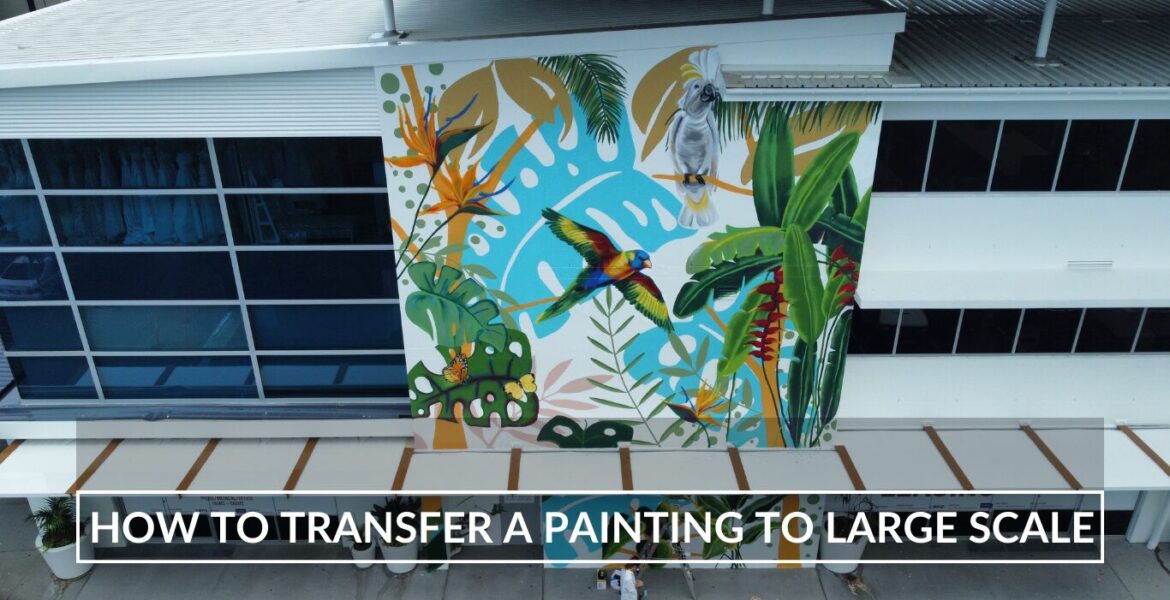
How to transfer a painting to large scale
The transition from a small-scale canvas to a larger-than-life mural can be an exhilarating challenge for artists seeking to make a bold statement with their work. I know I found this challenge super scary but exciting, and by the end, it was so much easier than I thought it would be.
In this post, we explore the step-by-step process of transferring a painting to a large scale, providing insights and techniques to help artists successfully navigate the unique considerations of creating monumental artworks.
- Choose the Right Painting: Before diving into the enlargement process, carefully select a painting that lends itself well to a larger scale. Paintings with strong compositions, clear lines, and distinct elements often translate more effectively to larger dimensions. You have to think about how far away the paintings will be from the viewer. Are they high up on buildings? If so, creating something with minimal smaller elements will be more effective.
- Select a Suitable Surface: Consider the surface on which you’ll be creating your large-scale masterpiece. Whether it’s a wall, canvas, or another material, ensure that it can accommodate the size and weight of the mural. Preparing the surface with primer may be necessary to enhance adhesion and longevity.
- Measure and Scale: Accurate measurements are key to a successful enlargement. Measure the original painting and determine the desired dimensions for the larger version. Use proportional scaling to maintain the integrity of the composition as you translate it to a larger size.
- Grid Method: The grid method is a classic technique for scaling up artwork. Divide both the original and the larger surface into a grid of equal squares. Transfer the contents of each square from the small-scale painting to the corresponding square on the larger surface, ensuring accuracy and maintaining proportions.
- Projector Method: If precision is paramount, consider using a projector to enlarge your painting. Project the image onto the larger surface and trace the outlines. This method is particularly effective for intricate details and maintaining the fidelity of the original work. I’ve used a projector for more complicated murals, like my Star Wars Death Star mural. But you do need space to be able to have the projector far enough away, and low lighting/access at night.
- Tracing Paper Transfer: Another method involves using tracing paper to transfer the outlines of the original painting onto the larger surface. Secure the tracing paper over the small-scale painting, trace the lines, and then transfer the traced image onto the larger canvas or wall. This is probably only appropriate for smaller murals and something I have used for elements of a mural too.
- Adjust and Refine: As you transfer the painting to a larger scale, take the opportunity to make adjustments and refinements. Some details may need to be modified to suit the new size, and colours may need to be adjusted for visual impact.
- Choose the Right Medium: Consider the medium you’ll use for the large-scale painting. Acrylic and emulsion paints are popular choices for murals due to their durability and vibrant colours. Ensure that the chosen medium is compatible with the surface and provides the desired effect.
- Create a Preliminary Sketch: Before diving into the final painting, create a preliminary sketch on the larger surface. This allows you to assess the composition and make any necessary adjustments before committing to the final layers of paint.
- Execution and Final Touches: With the preparatory work complete, proceed to execute the final painting on the large scale. Take your time to add details, refine the composition, and ensure a cohesive and visually impactful result.
Transferring a painting to a large scale is a transformative process that requires careful planning, precision, and artistic vision. By choosing the right painting, employing accurate scaling methods, and selecting suitable techniques, artists can bring their creations to life on a grand scale. Whether adorning a wall or a massive canvas, the journey from small to large is an opportunity for artists to make a powerful statement and share their art with a broader audience.
Or if you feel confident, try free handing it… who knows, the end result may exceed all your expectations!
